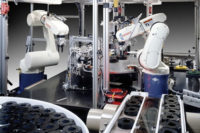WUHAN, China — Honda Motors has reopened its plant in Wuhan, China with additional precautions to ensure worker safety.
Temperature checkpoints and posters telling workers to keep more than a meter apart at Japanese automaker Honda’s reopened plant in the Chinese city of Wuhan show how the coronavirus has created a new normal on the factory floor.
The plant, a joint venture with Dongfeng Motor Group was shut in late January when authorities ordered a lockdown in Wuhan in a bid to stop the spread of the coronavirus, which emerged there late last year.
It reopened on March 11 to resume operations in stages and is now back to pre-virus production levels, according to Li Shiquan, assistant director of the joint venture's No. 2 final assembly plant.
About 98 percent of the plant’s 12,000 workers were now back and were putting in over-time to make up for lost production. The joint venture produced 800,000 cars last year.
“We have many customers who are waiting for cars so this week we have arranged for each worker to work 1.5 hours more,” says Li.
A sign hanging from the ceiling in the factory said the goal was 1,237 cars that day, 17 percent higher than the 1,060 it usually produced.
Plants at Honda's Guangzhou-based joint venture with GAC are also running extra shifts, says GAC's chairman Zeng Qinghong.
The central industrial hub of Wuhan started allowing people to leave the city on Wednesday in what is seen as a turning point for China's fight against the coronavirus. China's factories begun to reopen weeks ago as infection rates in their localities began to drop off.
Honda has since suspended operations in the United States and Canada, its biggest manufacturing hub, until May 1. It has also stopped output at plants in countries ranging from Britain to Thailand, and has announced intermittent stoppages at some of its Japanese plants.
The Wuhan plant reopened after the government approved its plan to curb infection risks. The plant's smoking and rest areas have been shut to stop people from gathering while meetings have to be held on video links. Workers needing a rest from the assembly line are encouraged to sit on stools spaced out on the factory floor.
Pasted on pillars were QR codes, which workers use their mobile phones to scan in order to fill in forms daily asking about any coughing or contacts with unwell people. Li said no coronavirus cases had been found since the plant resumed operations.



